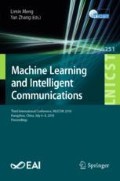Abstract
This paper focuses on the design of radio frequency identification (RFID) data-driven vehicle speed prediction method using adaptive Kalman filtering. First of all, when the vehicle moves through a RFID tag, the reader needs to acquire the state information (i.e., current speed and time stamp) of the last vehicle across the tag, and meanwhile transmits its state information to this tag. Then, the state space model can be formulated according to the acquired state information. Finally, the adaptive Kalman filtering algorithm is proposed to predict and adjust the speed of vehicles. Adaptive Kalman filtering algorithm achieves the adaptive updating of variable forgetting factor by analyzing the error between the expected output value and the actual output value, so as to achieve the online updating of the prediction model. The numerical results further show that compared with the conventional Kalman filtering algorithm, the proposed algorithm can increase the speed prediction accuracy by 20%. This implies that the proposed algorithm can provide the better real-time effectiveness for the practical implementation.
Access this chapter
Tax calculation will be finalised at checkout
Purchases are for personal use only
References
Yang, M., Dong, B., Wang, H., et al.: Laser radar based real time ego-motion estimation for intelligent vehicles. In: IEEE Intelligent Vehicle Symposium, vol. 1, pp. 44–51 (2002)
Floudas, N., Polychronopoulos, A., Amditis, A.: A survey of filtering techniques for vehicle tracking by radar equipped automotive platforms. In: International Conference on Information Fusion, vol. 2, pp. 25–28 (2005)
Zamiri, S., Reitinger, B., Grun, H., et al.: Laser ultrasonic velocity measurement for phase transformation investigation in titanium alloy. In: IEEE International Ultrasonics Symposium, pp. 683–686 (2013)
Titov, S.A., Maev, R.G., Bogachenkov, A.N.: An ultrasonic array technique for velocity of bulk waves and sample thickness measurement. In: IEEE International Ultrasonics Symposium, pp. 2384–2387 (2010)
Kalashnikov, A.N., Challis, R.E.: Errors and uncertainties in the measurement of ultrasonic wave attenuation and phase velocity. IEEE Trans. Ultrason. Ferroelectr. Freq. Control 52, 1754–1768 (2005)
Shen, Q., Ban, X.-J., Chang, Z., et al.: On-line detection and temporal segmentation of actions in vidio based human-computer interaction. Chin. J. Comput. 38(12), 2477–2487 (2015)
Kloos, G., Guivant, J.E., Worrall, S., et al.: Wireless network for mining applications. In: Australasian Conference on Robotics and Automation, Canberra, Australia, December 2004
Yoon, J.-H., Peng, H.: A cost-effective sideslip estimation method using velocity measurements from two GPS receivers. IEEE Trans. Veh. Technol. 63, 2589–2599 (2014)
Bhavsar, S.S., Kulkarni, A.N.: Train collision avoidance system by using RFID. In: International Conference on Computing, Analytics and Security Trends, pp. 30–34 (2016)
Li, J., Jin, M., Luan, S.: Intriduction radio frequency identification technology. Comput. Knowl. Technol. 6(15), 4238–4240 (2010)
Liu, W., Ning, H., Wang, B.: REID antenna design of highway ETC in ITS. In: International Symposium on Antennas, Propagation and EM Theory, pp. 1–4 (2006)
Guo, Y., Zhao, Z.: Design of school bus passengers’ identity authentication system based on RFID. In: IEEE International Conference on Communication Problem-Solving, pp. 412–415 (2015)
Lee, L.T., Tsang, K.F.: An active RFID system for railway vehicle identification and positioning. In: International Conference on Railway Engineering - Challenges for Railway Transportation in Information Age, pp. 1–4 (2008)
Huo, Y., Lu, Y., Cheng, W., et al.: Vehicle road distance measurement and maintenance in RFID systems on roads. In: 2014 International Conference on Connected Vehicles and Expo, pp. 30–36 (2014)
Qiong, D., Yang, X., Zhu, J.: Study on tracking algorithm for wMPS based on least square Kalman filter. Chin. J. Sens. Actuators 25(2), 236–239 (2012)
Jing, J., Filev, D., Kurt, A., et al.: Vehicle speed prediction using a cooperative method of fuzzy Markov model and auto-regressive model. In: 2017 IEEE Intelligent Vehicles Symposium, pp. 881–886 (2017)
Chen, X., Ling, Y., Chen, M.: Mobile robot localization algorithm based on gaussian mixture consider Kalman filter in WSNs environment. Chin. J. Sens. Actuators 30(1), 133–138 (2017)
Welch, G., Bishop, G.: An Introduction to the Kalman Filter. University of North Carolina at Chapel Hill, vol. 8, no. 7, pp. 127–132 (2006)
Sun, Y., Zhang, C.: Research on the detection method of airport pavement joint seeper based on Kalman filter. Chin. J. Sens. Actuators 30(8), 1204–1208 (2017)
Heidari, A., Khandani, A.K., Mcavoy, D.: Adaptive modelling and long-range prediction of mobile fading channels. IET Commun. 4, 39–50 (2010)
Cai, X., Cai, M., Zhang, Y.: Research on driver reaction time in internet of vehicles environment. J. Comput. Appl. 37(S2), 270–273 (2017)
Yang, L., Xing, C., Zhao, H.: Study on driver’s reaction time (DRT) during car following. Comput. Technol. Autom. 34(3), 33–37 (2015)
Acknowledgement
This work was supported in part by the National Natural Science Foundation of China under Project 61379122, Project 61572440, and Project 61502428, and in part by the Zhejiang Provincial Natural Science Foundation of China under Project LR16F010003, and Project LR17F010002.
Author information
Authors and Affiliations
Corresponding author
Editor information
Editors and Affiliations
Rights and permissions
Copyright information
© 2018 ICST Institute for Computer Sciences, Social Informatics and Telecommunications Engineering
About this paper
Cite this paper
Feng, A., Qian, L., Huang, Y. (2018). RFID Data-Driven Vehicle Speed Prediction Using Adaptive Kalman Filter. In: Meng, L., Zhang, Y. (eds) Machine Learning and Intelligent Communications. MLICOM 2018. Lecture Notes of the Institute for Computer Sciences, Social Informatics and Telecommunications Engineering, vol 251. Springer, Cham. https://doi.org/10.1007/978-3-030-00557-3_5
Download citation
DOI: https://doi.org/10.1007/978-3-030-00557-3_5
Published:
Publisher Name: Springer, Cham
Print ISBN: 978-3-030-00556-6
Online ISBN: 978-3-030-00557-3
eBook Packages: Computer ScienceComputer Science (R0)

